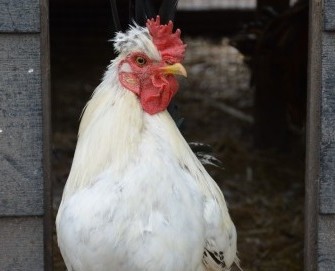Surprise bacterium linked to lameness in broilers
A bacterium not previously known to affect chickens is now thought to be the cause of lameness in broilers, according to University of Arkansas researchers.[1]
“We have identified Staphylococcus agnetis as significantly involved in bacterial chondronecrosis with osteomyelitis (BCO)…,” the researchers say.
BCO is one of the most common causes of lameness in commercial broilers. It’s a major economic and welfare concern for poultry producers, but relatively little is known about the microbial communities associated with BCO.[2]
In their study, the researchers raised broilers on wire flooring, which has been known to enhance the development of lameness. Next they tested overtly lame birds for bacteria in BCO lesions and found S. agnetis was the predominant genus (Table 1).
Table 1. Bacterial species identified by PCR-sequencing from 24 lame birds based on sampling of the right and left femurs, right and left tibias and blood
| Bacterial species | Total found |
| Enterococcus faecalis | 0 |
| Staphylococcus agnetis | 81 |
| Staphylococcus aureus | 3 |
| Staphylococcus epidirmidis | 2 |
| Staphylococcus hominis | 3 |
| Staphylococcus saprophyticus | 1 |
| Staphylococcus xylosus | 2 |
Note: Table adapted from the PLOS ONE article
Water-induced
The researchers were also able to induce BCO by administering S. agnetis through the drinking water. They had four pens with 50 chicks each that received bacteria in water for two successive days at 7 and 14 days of age. Of the chicks that received S. agnetis, 40% (20 birds) developed BCO lameness, they report in the open-access journal PLOS ONE.
In contrast, the incidence of BCO was only 2% (1 bird) in the group that received Enterococcus faecalis, 42% (21 birds) in the group that received both E. faecalis and S. agnetis and 10% (5 birds) in the group that received no bacteria in the water, say Adnan A.K. Al-Rubaye, PhD, and colleagues. The simultaneous administration of E. faecalis with S. agnetis did not affect the total incidence, they add.
“It should be noted that lame birds were not identifiable until beginning with day 35, which is 19 days after the final inoculation,” the researchers continue. “Thus, exposure to live S. agnetis bacteria in the water at an early age can induce BCO lameness.”
Prior to their studies, they continue, S. agnetis was not reported in poultry and had only been identified as an occasional pathogen in cattle mastitis. S. agnetis appears to be most closely related to Staphylococcus hyicus, a major agent of exudative dermatitis in swine. Molecular typing has also identified highly similar DNA sequences in the guts of sheep scab mites.
Possible vectors
Due to high-density mixed farming, the complex of highly related S. hyicus and S. agnetis species affecting cattle, pigs and chickens may have resulted from mild zoonoses that have become more significant pathogens in some of these animals.
Because there is evidence from DNA sequencing that a closely related bacterium is present in sheep scab mites, it’s possible S. agnetis is transmitted by mites or between cattle and poultry by other vectors, the researchers speculate.
They point out there is still much to be learned. “Although we showed we could induce lameness by administration of S. agnetis in the water, we do not know the actual reservoir for the ‘natural’ bacterial infection. This could be from biofilms in or on the nipple waterers, insect-vectored transmission, bird-to-bird contact or even vertical transmission through the egg,” they say.
It will be important to determine whether S. agnetis isolates from cattle mastitis have the same pathogenicity in broilers as the isolates identified in their studies.
“It will also be critical to examine bacterial species distributions in BCO in other flocks and farms. We have only investigated bacterial species in BCO in broilers at the University of Arkansas poultry research farm, which is in close proximity to sheep and cattle,” they say.
The full scientific report can be accessed here.
[1] Al-Rubaye A, et al. Genome Analysis of Staphylococcus agnetis, an Agent of Lameness in Broiler Chickens. PLOS ONE, November 25, 2015. http://journals.plos.org/plosone/article?id=10.1371/journal.pone.0143336. Accessed January 28, 2016.
[2] Jiang T, et al. Molecular survey of bacterial communities associated with bacterial chondronecrosis with osteomyelitis (BCO) in broilers. PLOS ONE. 2015 Apr 16;10(4):e0124403.
Posted on March 19, 2016














